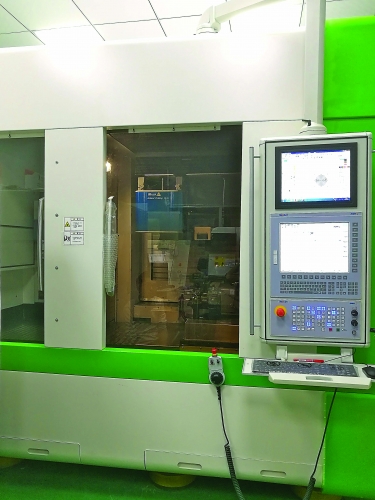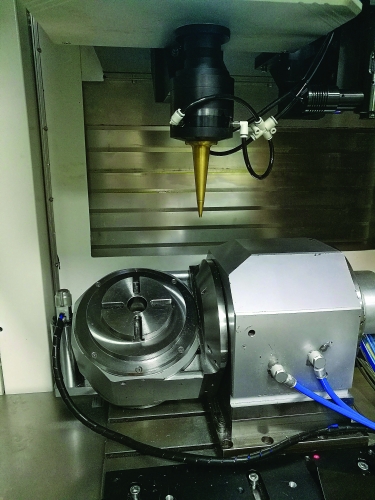Chinese machine tool builder Original Point Machine Tools has developed a multifunctional CNC machining center that combines milling and high-speed laser-cutting capabilities.
OPMT, a small company based in China’s Guangdong province, was asked by Guangdong University of Technology to develop the combo machine. To tackle the project, OPMT partnered with NUM China, a subsidiary of Switzerland-based NUM AG, to tap the firm’s CNC expertise. OPMT also enlisted another Chinese firm, Xi’an Zhongke Microcrystalline Manufacturing Co., to provide the laser system, as well as the Chinese Academy of Sciences to help with some of the complex material-processing issues.
The result of this joint effort is the ML125, which the partners describe as a unique 8-axis machining center that includes separate milling and laser-cutting workstations. During machining operations, parts can be transported between the two workstations.

OPMT’s new ML125 8-axis machining center combines milling and laser-cutting functions. Image courtesy of NUM
Milling is done by a milling head powered by a 40,000-rpm spindle motor. Meanwhile, laser cutting is done by a dual laser head featuring a pair of ultrashort pulse lasers; these USPLs emit pulses of light measured in picoseconds (trillionths of a second) or femtoseconds (quadrillionths of a second). The pulses are so short that the heat-affected zone in the machined material is, if not eliminated, at least significantly smaller than what is normally caused by laser cutting. As a result, little or no post-processing is needed to deal with thermal damage.
When processing metals, femtosecond lasers provide higher quality, while picosecond lasers usually cut faster. Both options are available to users of the ML125. The machine’s dual laser head can switch between a 20w picosecond laser for high-speed cutting and a 10w femtosecond laser for improved process quality. Capable of drilling and cutting almost any material, the femtosecond laser has a very short 1,030nm wavelength, making it suitable for microscale and nanoscale processing.

The ML125 has a dual laser head capable of both high-speed and high-quality cutting. Image courtesy of NUM
Controlled by NUM’s latest-generation Flexium+ 68 CNC platform, the ML125 has eight servo axes, two independent NC channels (one for the milling workstation and another for the laser-cutting workstation) and application-specific I/O ports embedded in the NC CPU box; these allow fast data transfers during the motion cycle. Movement of the fully articulated laser head is controlled by five NUMDrive X servodrives with high-speed interpolation between the five axes. All the machine’s milling and laser-cutting actions can be monitored with a single display panel set.
Thanks to a special hollow-shaft torque motor and a linear motor drive, the dual laser head offers positional accuracy of 8µm, along with repeatability of 5µm, according to NUM. In addition, the company stated that the associated A/C-axis rotation platform has a precision rotary feed function with positional accuracy of 5 arc minutes.
NUM also pointed out that improved process accuracy is one advantage of combining milling and laser cutting in a single machine. The boost in accuracy stems from the need for only a single clamping operation to perform processes on a workpiece—normally these operations are completed on separate machines. One-time part location also shortens the machining process, NUM added.
Installed in a research laboratory at Guangdong University of Technology, the ML125 machining center is capable of processing many different materials, including metal, ceramics, glass and cemented carbide.
No plans have been announced to make the ML125 available to others. But according to NUM, the multifunctional machining center could have what it takes to meet the needs of many manufacturing firms, mainly in the medical industry.
“The requirements of the industrial processing market keep changing, which means that our machines need to be extremely flexible so that they always offer customers what they need,” said Bruce Zheng, CEO of OPMT.
Related Glossary Terms
- ceramics
ceramics
Cutting tool materials based on aluminum oxide and silicon nitride. Ceramic tools can withstand higher cutting speeds than cemented carbide tools when machining hardened steels, cast irons and high-temperature alloys.
- computer numerical control ( CNC)
computer numerical control ( CNC)
Microprocessor-based controller dedicated to a machine tool that permits the creation or modification of parts. Programmed numerical control activates the machine’s servos and spindle drives and controls the various machining operations. See DNC, direct numerical control; NC, numerical control.
- feed
feed
Rate of change of position of the tool as a whole, relative to the workpiece while cutting.
- gang cutting ( milling)
gang cutting ( milling)
Machining with several cutters mounted on a single arbor, generally for simultaneous cutting.
- heat-affected zone
heat-affected zone
That portion of the base metal that was not melted during brazing, cutting or welding, but whose microstructure and mechanical properties were altered by the heat.
- interpolation
interpolation
Process of generating a sufficient number of positioning commands for the servomotors driving the machine tool so the path of the tool closely approximates the ideal path. See CNC, computer numerical control; NC, numerical control.
- linear motor
linear motor
Functionally the same as a rotary motor in a machine tool, a linear motor can be thought of as a standard permanent-magnet, rotary-style motor slit axially to the center and then peeled back and laid flat. The major advantage of using a linear motor to drive the axis motion is that it eliminates the inefficiency and mechanical variance caused by the ballscrew assembly system used in most CNC machines.
- machining center
machining center
CNC machine tool capable of drilling, reaming, tapping, milling and boring. Normally comes with an automatic toolchanger. See automatic toolchanger.
- milling
milling
Machining operation in which metal or other material is removed by applying power to a rotating cutter. In vertical milling, the cutting tool is mounted vertically on the spindle. In horizontal milling, the cutting tool is mounted horizontally, either directly on the spindle or on an arbor. Horizontal milling is further broken down into conventional milling, where the cutter rotates opposite the direction of feed, or “up” into the workpiece; and climb milling, where the cutter rotates in the direction of feed, or “down” into the workpiece. Milling operations include plane or surface milling, endmilling, facemilling, angle milling, form milling and profiling.
- numerical control ( NC)
numerical control ( NC)
Any controlled equipment that allows an operator to program its movement by entering a series of coded numbers and symbols. See CNC, computer numerical control; DNC, direct numerical control.
- tap
tap
Cylindrical tool that cuts internal threads and has flutes to remove chips and carry tapping fluid to the point of cut. Normally used on a drill press or tapping machine but also may be operated manually. See tapping.








